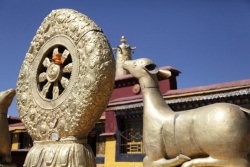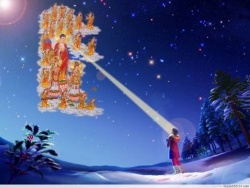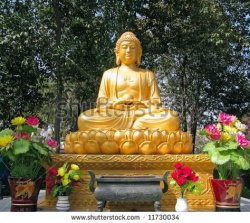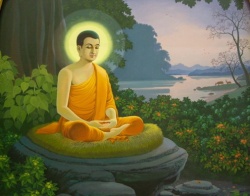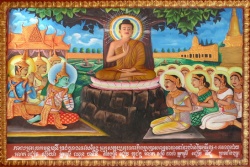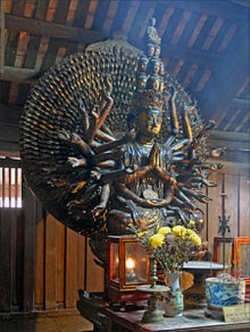Difference between revisions of "Dharmadhatu"
m (Text replacement - "end" to "end") |
|||
| Line 4: | Line 4: | ||
1) The content of the [[mind]]; | 1) The content of the [[mind]]; | ||
| − | 2) all-encompassing [[space]] ({{Wiki|matrix}}) in which all [[phenomena]] of any sort arise and fall, without beginning or | + | 2) all-encompassing [[space]] ({{Wiki|matrix}}) in which all [[phenomena]] of any sort arise and fall, without beginning or end; or |
3) the [[universe]] itself with all its world-systems and {{Wiki|societies}} of [[beings]]. | 3) the [[universe]] itself with all its world-systems and {{Wiki|societies}} of [[beings]]. | ||
Revision as of 13:46, 30 December 2014
Dharmadhatu (chos kyi dbyings). The 'realm of phenomena;' the suchness in which emptiness and dependent origination are inseparable. The nature of mind and phenomena which lies beyond arising, dwelling and ceasing. dharmadhatu (fa-jie, cho ying) has several meanings:
1) The content of the mind;
2) all-encompassing space (matrix) in which all phenomena of any sort arise and fall, without beginning or end; or
3) the universe itself with all its world-systems and societies of beings.
It is also used to express absolute reality or the emptiness that is the essence of phenomena.
Dharmadhatu: the realm of all dharmas. The Four Dharmadhatu (Chinese: 四法界), is a philosophical concept propagated by Master Tu-shun (Chinese: 杜順; 557-640 CE). It builds upon and is a variant of the Dharmadhatu doctrine. Tu-shun is the founder of Hua-yan (Chinese: 華嚴) school. The Four Dharmadhatu were outlined in Tu-shun's treatise which has been rendered into English as 'On the Meditation of Dharmadhātu'. The Four Dharmadhatu are:
The Dharmadhātu of Shih' (Chinese: 事法界; "shi fajie"). 'Shih' is a rendering of the character 事 which holds the semantic field: "matter", "phenomenon", "event". It may be understood as the 'realm' (Sanskrit: dhātu) of all matters and phenomena.
The Dharmadhātu of Li' (Chinese: 理法界; "li fajie"). 'Li' is a rendering of the character 理 which holds the semantic field: "principle", "law", "noumenon". This 'realm' (Sanskrit: dhātu) may be understood as that of principles. It has been referred to as "the realm of the one principle". The "one principle" being qualified as śūnyatā (Sanskrit).
The Dharmadhātu of Non-obstruction of Li against Shih' (Chinese: 理事無礙法界; "lishi wuai fajie"). This 'realm' (Sanskrit: dhātu) has been rendered into English as "the realm of non-obstruction between principle and phenomena".
The Dharmadhātu of the Non-obstruction of Shih and Shih' (Chinese: 事事無礙法界; "shishi wuai fajie"). This 'realm' (Sanskrit: dhātu) has been rendered into English as "the realm of non-obstruction between phenomena".
the 4 Dharmadhatu kind of explain how selflessness of phenomena work in 4 different levels. the final level is the most difficult to understand. 事事无碍. those who reached this level do not judge between good or bad. to them good is good. bad is also good. this is the realm of non-obstruction between All phenomena.
Dharmadhatu (Sanskrit) is the 'dimension', 'realm' or 'sphere' (dhatu) of Dharma and denotes the collective 'one-taste' (Sanskrit: ekarasa) dimension of Dharmata.
==Nomenclature, orthography and etymology==
In Mahayana Buddhism, dharmadhātu (Standard Tibetan: chos kyi dbyings; Chinese: 法界) means "realm of phenomena", "realm of Truth", and of the noumenon.
In this realm, Tathata (Reality "as-it-is"), emptiness, dependent co-arising and the unconditioned, uncreated, perfect and eternal Buddha are one.
It is "not only the extent or expanse of Infinity but also its deepest nature, or essence".
Dharmadhātu is the purified mind in its natural state, free of obscurations. It is the essence-quality or nature of mind, the fundamental groun] of consciousness of the trikaya, which is accessed via the mindstream.
When the buddha-nature has been realised, dharmadhātu is also referred to as the Dharmakāya, the Body of Dharma Truth.
It is one of the Five Wisdoms:
- Dharmadhātu wisdom,
- Mirror-like wisdom,
- Equality wisdom,
- Discriminating wisdom,
- All-accomplishing wisdom.
- It is associated with Vairocana.
==Historical origin==
Kang-nam Oh traces the origin of dharmadhatu to the Avatamsaka Sutra. It has been further developed by the Hua-yen school:
This idea of dharmadhātu-pratītyasamutpāda which was originally found in the Avataṁsaka-sūtra or Hua-yen ching,[a] was fully developed by the Hua-yen school into a systematic doctrine palatable to the Chinese intellectual taste. The dharmadhātu doctrine[b] can be said to have been, by and large, set forth by Tu-shun (557~640 C.E.), formulated by Chih-yen (602~668), systematized by Fa-tsang (643~712), and elucidated by Ch’eng-kuan (ca. 737~838) and Tsung-mi (780~841).
Understanding in Buddhist tradition
Indian Buddhism
Śrīmālādevī Sūtra
The Śrīmālādevī Sūtra (2rd century CE ), also named The Lion's Roar of Queen Srimala, centers on the teaching of the tathagatagarbha as "ultimate soteriological principle". Regarding the tathagata-garbha it states:
- Lord, the Tathagatagarbha is neither self nor sentient being, nor soul, nor personality. The Tathagatagarbha is not the domain of beings who fall into the belief in a real personality, who adhere to wayward views, whose thoughts are distracted by voidness. Lord, this Tathagatagarbha is the embryo of the Illustrious Dharmadhatu, the embryo of the Dharmakaya, the embryo of the supramundane dharma, the embryo of the intrinsically pure dharma.
In the Śrīmālādevī Sūtra, there are two possible states for the Tathagatagarbha:
- [E]ither covered by defilements, when it is called only "embryo of the Tathagata"; or free from defilements, when the "embryo of the Tathagata" is no more the "embryo" (potentiality) but the Tathāgata (=the Dharmakaya)(actuality).
The sutra itself states it this way:
- This Dharmakaya of the Tathagata when not free from the store of defilement is referred to as the Tathagatagarbha.
Nagarjuna
Nāgārjuna wrote a treatise on the dharmadhatu, In praise of the Dharmadhatu. It is the ground which makes liberation possible:
- The dharmadhatu is the ground
- For buddhahood, nirvana, purity, and permanence. [c]
According to Nāgārjuna, the dharmadhatu is seen when the afflictions are purified:
- As butter, though inherent in the milk,
- Is mixed with it and hence does not appear,
- Just so the dharmadhatu is not seen
- As long as it is mixed together with afflictions.
- And just as the inherent butter essence
- When the milk is purified is no more disguised,
- When afflictions have been completely purified,
- The dharmadhatu will be without any stain at all.
Nāgārjuna defines bodhicitta as the medium through which dharmadhātu is perceived and realised:
- Sentient beings’ essence free of substance
- Is the sphere that is encountered on this plane.
- Seeing this is the royal bodhicitta,
- The dharmakaya free of every flaw.
Those who follow the Bodhisattva-path realize the dharmadhatu, or Dharmakaya:
- Just as the moon when it is new
- Visibly grows larger bit by bit,
- Those who have reached the bhumis
- See the dharmakaya more and more.
Chinese Buddhism
Mahaparinirvana Sutra
In the Mahayana Mahaparinirvana Sutra, the Buddha states of himself that he is the "boundless Dharmadhatu" - the Totality itself.
Yutang Lin
Yutang Lin is a student of Buddhist Yogi C. M. Chen, who established Adi Buddha Mandala, following seven "Tantric schools".
Yutang Lin qualifies the dharma in dharmadhātu, it:
- [R]refer[s] to spiritual states that transcend senses and consciousness, and are unspeakable or unimaginable. Under this meaning of "dharma" all dharmas are mutually dependent causes and conditions of their coexistence. Whatever the ordinary worldly view may be, in this sense of "dharma," all dharmas are equal as one of the dharmas and this equality transcends considerations of their differences in being real/unreal, superior/inferior, or abundant/deficient. In this sense of "dharma" the word "Dharmadhatu," literally "realm of dharmas," refers to the collection of all dharmas (Ch: fa chieh, fa jie). "Attaining Buddhahood" or "Attaining Dhammakaya" means having transcended all and any limitations that are due to artificial concepts, subconscious activities, desires and feelings, will and attachment, time and space, etc., and having regained the original state of Dharmadhatu in harmonious oneness.
Yutang Lin affirms the nonlinear, holistic essence-quality of dharmadhātu, unbounded by space and time:
- According to the correct view of Dharmadhatu all dharmas in the past, all dharmas at present and all dharmas in the future are all together in the Dharmadhatu. Dharmadhatu is neither limited by space nor by time.
Tibetan Buddhism
Dzogchen
In Dzogchen text Gold refined from ore the term Dharmadhatu is translated as 'total field of events and meanings' or 'field of all events and meanings.' Such translation seems to be paralleling a modern Western philosophical approach to Philosophy of time: Eternalism.
